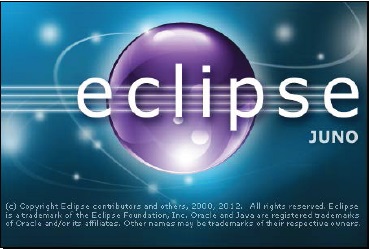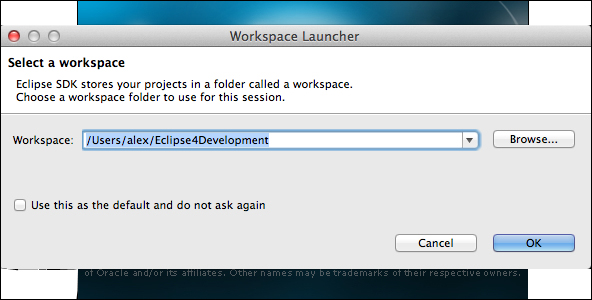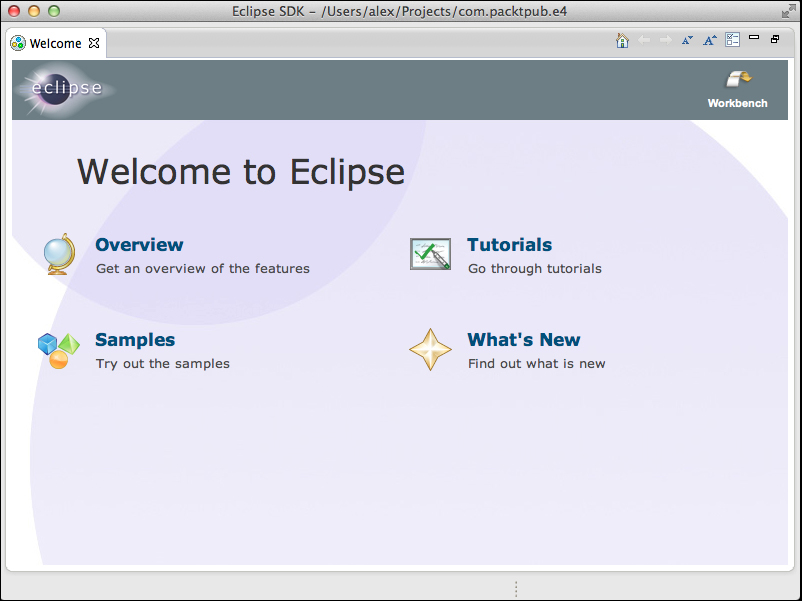Eclipse is a Java-based application, which needs Java installed. Eclipse is distributed as a compressed archive and doesn't require an explicit installation step.
To obtain Java, go to http://java.com and follow the instructions to download and install Java. Note that Java comes in two flavors; a 32-bit install and a 64-bit install. If the running OS is a 32-bit, install the 32-bit JDK; alternatively, if the running OS is 64-bit, install the 64-bit JDK.
Running
java -versionshould give output like so:java version "1.7.0_09" Java(TM) SE Runtime Environment (build 1.7.0_09-b05) Java HotSpot(TM) 64-Bit Server VM (build 23.5-b02, mixed mode)
Go to http://www.eclipse.org/downloads/ and select the Eclipse Classic or Eclipse Standard distribution.
Download the one which matches the installed JDK. Running
java -versionshould report either:If it's a 32-bit JDK:
Java HotSpot(TM) Client VMIf it's a 64-bit JDK:
Java HotSpot(TM) 64-Bit Server VM
To install Eclipse, download and extract the contents to a suitable location. Eclipse is shipped as an archive, and needs no administrator privileges. Do not run it from a networked drive as this will cause performance problems.
Note that Eclipse needs to write to the folder from which it is extracted, so it's normal that the contents are writable afterwards. Generally, installing into
/ApplicationsorC:\Program Files, while being logged in with administrator account, is not recommended.Run Eclipse by double-clicking on the Eclipse icon, or by running
eclipse.exe(Windows),eclipse(Linux), orEclipse.app(OS X).Upon startup, the splash screen should be shown:

Choose a workspace, which is the location in which projects are be stored, and click on OK:

-
Close the welcome screen by clicking on the cross icon
 in the tab next to the Welcome text. The welcome screen can be re-opened by navigating to Help | Welcome:
in the tab next to the Welcome text. The welcome screen can be re-opened by navigating to Help | Welcome:

Eclipse needs Java to run, and so the first step involved in installing Eclipse is ensuring that an up-to-date Java installation is available. By default, Eclipse will find a copy of Java installed on the path or from one of the standard locations. It is also possible to specify a different Java version by using the -vm command-line argument.
If the splash screen doesn't show up, the Eclipse version may be incompatible with the JDK (for example, a 64-bit JDK with a 32-bit Eclipse, or vice-versa). Common error messages shown at the launcher may include Unable to find companion launcher or a cryptic message about being unable to find an SWT library.
On Windows, there is an additional eclipsec.exe launcher, which allows log messages printed to the console to be seen. This is sometimes useful if Eclipse fails to load and no other message is displayed. Other operating systems can use the eclipse command. Both eclipse.exe and eclipse support the -consolelog argument, which can display more diagnostic information about problems while launching Eclipse.
The Eclipse workspace is a directory used for two purposes: as the default project location, and to hold the .metadata directory containing Eclipse settings, preferences, and other runtime information. The Eclipse runtime log is stored in the .metadata/.log file.
The workspace chooser dialog has an option to set the chosen value as the default workspace. It can be changed within Eclipse by navigating to File | Switch Workspace. It can also be overridden by specifying a different workspace location with the -data command-line argument.
Finally, the welcome screen is useful for first-time users, but is worth closing (rather than minimizing) once Eclipse has started.



